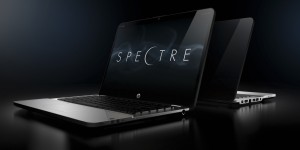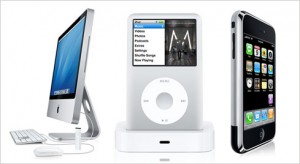 On The Tech Report, Scott Wasson complains that this year’s CES is dominated by not much more than a bunch of clones of Apple products. While I think he may be overlooking some of the more important announcements that have been made, it is true that a lot of the bitching and complaining about Apple products comes, in some part, from our envy of the way they work. Is it such a bad thing for the PC industry to be interested in styling their products after Apple devices? I think it’s great, and it is a testament to both the innovations that have been made by Apple, as well as the benefits we get from the fierce competitiveness of the PC industry.
On The Tech Report, Scott Wasson complains that this year’s CES is dominated by not much more than a bunch of clones of Apple products. While I think he may be overlooking some of the more important announcements that have been made, it is true that a lot of the bitching and complaining about Apple products comes, in some part, from our envy of the way they work. Is it such a bad thing for the PC industry to be interested in styling their products after Apple devices? I think it’s great, and it is a testament to both the innovations that have been made by Apple, as well as the benefits we get from the fierce competitiveness of the PC industry.
I am currently writing this article on an HP Envy 14. One of the first things I noticed about this product was that it was styled very much like the Macbook Pro, and it was clear to me that HP was gunning for Apple with this product. Some of the more noticeable features that were clear MBP ripoffs are the light-up, chicklet-style keys, multi-touch touchpad (with TWO mouse buttons, I might add) slot-style optical drive, aluminum casing, mini Displayport output, light-up HP logo and Beats Audio sound driver software.
As a DJ and producer, it is often an inconvenience for me to be PC-based, because of what the Macbook Pro offers to people in my industry. Any audio engineer will tell you that the CoreAudio system found in Apple products is light years ahead of the stock WDM audio drivers that typically come with a laptop or desktop with system-integrated sound, and a bit more stable than ASIO—even though the differences are hardly noticeable, even to a trained ear. Along with CoreAudio comes the proprietary Audio Units plugin system that is much more stable to use than the often wonky, cross-platform VSTs.
 That’s why it was great to see a product that had all of the great features that I was being told that I was missing by not using Apple products, and to have something that looks great perched on my laptop stand on stage. However, I still felt that the product fell short in some areas, the biggest issue being that it’s about twice as thick and weighs twice as much as a Macbook Pro.
That’s why it was great to see a product that had all of the great features that I was being told that I was missing by not using Apple products, and to have something that looks great perched on my laptop stand on stage. However, I still felt that the product fell short in some areas, the biggest issue being that it’s about twice as thick and weighs twice as much as a Macbook Pro.
Naturally, I got a megahuge raging nerd boner when I saw the teaser video and photos of the new Envy Spectre. It looks even more like a Macbook Pro—thin and lightweight, and boasting a few new exclusive features to set it apart from the competition. They have really pushed the chassis design with this product by making it mostly out of glass, and has deservedly earned its spot as one of the most talked-about new products showcased at CES.
Ultrabooks and tablets are also a big hit this year, all with new features that set them apart from their Apple counterparts. The complete line of Intel-based ultrabooks, for example, will give consumers a lot more options than the Macbook Air. The ASUS Transformer Prime tablet has a docking system that takes tablet computing to the next level. Even Microsoft has joined the bandwagon with their touch-oriented Windows 8 operating system, and the obligatory app store that comes with it.
Up until recently, Apple was having a very difficult time sparking innovation among hardware developers. Even with their growing popularity, it was never enough to get IBM to design a competitive PowerPC CPU that could compete with the new x64 architecture that was driving the PC industry forward. Eventually they dropped the PowerPC platform and moved to Intel processors, making them just as good at running Mac OS X as they were at running Windows. In contrast, Apple was recently able to spark innovation in the PC industry, by working with Intel to create Thunderbolt, which is slowly starting to creep into our PCs. Apple has come a long way in the past seven years, and this goes without mentioning the way they revolutionized portable devices for more than a decade.
 Where Apple has seen most of its success, however, is in the integration scheme of their products—completely blowing their nearest competitor, Sony, clear out of the water. The way Apple devices integrate with each other to provide a uniform experience to the end-user is quite spectacular, and that is something I’m surprised we don’t see more of at CES.
Where Apple has seen most of its success, however, is in the integration scheme of their products—completely blowing their nearest competitor, Sony, clear out of the water. The way Apple devices integrate with each other to provide a uniform experience to the end-user is quite spectacular, and that is something I’m surprised we don’t see more of at CES.
But then again, I think that is what separates a typical Apple user from a typical PC user. An Apple user is more likely to buy a bunch of Apple products because of the way they work together, while a PC user is more likely to shop around to find the more specific features they are looking for, with specific price goals in mind, and rely on open standards and cooperation between OEMs for their capacity to integrate with each other. We need that separation in order to maintain a technology market that truly caters to market demands. It’s one of the only true free enterprises we have left.
I do not see the trend of “cloning” of Apple products going away anytime soon. Nor will Apple cease to push the boundaries of how we think of technology. Apple has always stayed a step ahead of the competition, and we can only hope they will continue to do so in the absence of Steve Jobs. We need Apple’s innovations as much as we need a dozen OEMs behind them, cloning and improving upon said innovations. In the end it will all lead to more options for the end-user, and ensure the momentum that has been built in the personal computer industry over the last 30+ years will continue forward.













 Articles RSS
Articles RSS